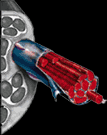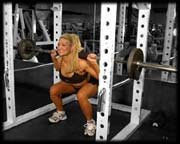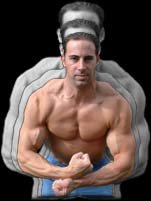Did you know muscles are key to good health?
Paula Goodyer

Photo: mauro grigollo
If you still see exercise as an optional extra, not a health
essential, science is finding more reasons to change your mind -
including new research that suggests strong muscles are good medicine.
One of the most compelling recent findings is that muscles
are actually a huge secretory organ. When we exercise them, they release
hormone-like chemicals that have a major influence on every system of
the body, says Rob Newton, foundation professor of exercise and sports
science at Western Australia's Edith Cowan University.
The effects of these chemicals - called myokines - include
reducing the low-level inflammation in the body thought to contribute to
heart disease, type 2 diabetes and Alzheimer's - and possibly working
as tumour suppressants.
''Some studies have found that extracting blood from
exercising humans and adding it to cancer cells in test tubes slows the
rate of cell reproduction,'' he says. ''In a study of mice, the growth
of breast cancer cells was halted in mice that exercised, while the
cancer continued developing in mice that were inactive.''
This may be one reason exercise appears to help reduce the risk of some cancers and improve survival in people with cancer.
''Some types of exercise, including strength training, also
produce a surge of the hormone testosterone, which helps sharpen
thinking and memory,'' he adds.
Then there's the effect of exercise on mitochondria, the
little energy ''factories'' in our cells. When you exercise, your body
makes more mitochondria - and the more you have the more you can do.
''But when you're inactive, the numbers of mitochondria
decline so it gets harder to do things,'' Newton explains. ''If you
become ill when you already have fewer mitochondria, it's harder to
recover. ''
Examples like these show why an exercise habit is like a
pill that boosts energy, strength and improves resistance to disease,
he says.
And if we want to reduce the risk of inactivity-driven
diseases such as heart disease, diabetes, cancer and Alzheimer's, we
need a regular dose all the way from childhood to old age.
by 21st-century lifestyles. When did you last see a toddler walking in a
shopping centre? It's more common to see toddlers and even older
children sitting in strollers or shopping trolleys and it's easy to see
why. Wheeling children around is more convenient than walking at their
pace. Yet if you check Australia's latest Physical Activity Guidelines,
spending long periods in car seats and strollers isn't on the to-do
list. ''All children (birth to five years) should not be sedentary,
restrained, or kept inactive for more than one hour at a time, with the
exception of sleeping,'' is the advice.
''Once I would have said that it's in the teens when children
leave school that physical activity declines, but kids are becoming
less active at younger ages,'' Newton says. ''Screen time is up but
there are also other factors, including concerns about litigation or
safety that lead to limits on what children are allowed to do - like
banning monkey bars or even lunchtime sport in some schools.''
And although we hear a lot about kids needing calcium for strong bones, only physical activity will build bone, he says.
Ironically, among the tips for bone and muscle-building moves for five to 12-year-olds from the Physical Activity Guidelines
is climbing or swinging on monkey bars and climbing frames. Other
suggestions are games such as tug o' war (great for muscle) and
hopscotch (because jumping is good for strengthening bone), along with
dance, gymnastics and martial arts.
Prime time for bone growth is childhood, adolescence and
young adulthood - getting as much bone in the ''bank'' between then and
30 is a hedge against the gradual bone loss that starts after 40.
families, time is limited, but being physically active helps mind and
body work better, improving productivity, Newton says. ''If you say,
'I've got kids - there's no time to exercise', it's worth remembering
that you won't be much good for your kids if you have a heart attack.''
While aerobic exercise to prevent heart disease is important,
we also need two to three sessions of strength training a week, he
says.
''Doing aerobic exercise like walking, running or cycling and
ignoring strength exercises is like remembering to change the oil in
the car regularly but ignoring the transmission fluid.''
''If you're planning to travel in retirement but get to 65
with problems - overweight, arthritis and muscle loss - it won't be so
much fun,'' says Newton, stressing that conserving muscle and bone with
strength training helps head off frailty further down the track.
''Walking is terrific for helping to prevent cardiovascular disease but does nothing for building muscle or bone,'' he says.
''Regular strength training also provides muscles with a
built-in repair kit. It causes satellite cells attached to the outside
of muscle cells to proliferate and donate nuclei to muscle tissue,
allowing new cells to grow and repair - so even though you're older,
muscles are still strong and tuned for repair and growth.
''Exercising muscle also helps control blood glucose levels.
If you have low muscle mass you can't control blood-sugar levels so
well, increasing diabetes risk.''
are 20 or 30-somethings doing CrossFit, but strength training now has
considerable traction with the over-60s, Newton says. Many have joined Living Longer, Living Stronger - a program of strength-training classes, available in some states, to reduce age-related decline and improve health.
''It doesn't have to be strength training at the gym - it can
be gardening if there's lifting and digging involved. The No. 1 reason
people go into dependent care is frailty. This is the age group with the
most to lose if muscle strength dwindles, but a lot to gain if they can
slow muscle loss.''
Paula Goodyer

Photo: mauro grigollo
If you still see exercise as an optional extra, not a health
essential, science is finding more reasons to change your mind -
including new research that suggests strong muscles are good medicine.
One of the most compelling recent findings is that muscles
are actually a huge secretory organ. When we exercise them, they release
hormone-like chemicals that have a major influence on every system of
the body, says Rob Newton, foundation professor of exercise and sports
science at Western Australia's Edith Cowan University.
The effects of these chemicals - called myokines - include
reducing the low-level inflammation in the body thought to contribute to
heart disease, type 2 diabetes and Alzheimer's - and possibly working
as tumour suppressants.
''Some studies have found that extracting blood from
exercising humans and adding it to cancer cells in test tubes slows the
rate of cell reproduction,'' he says. ''In a study of mice, the growth
of breast cancer cells was halted in mice that exercised, while the
cancer continued developing in mice that were inactive.''
This may be one reason exercise appears to help reduce the risk of some cancers and improve survival in people with cancer.
''Some types of exercise, including strength training, also
produce a surge of the hormone testosterone, which helps sharpen
thinking and memory,'' he adds.
Then there's the effect of exercise on mitochondria, the
little energy ''factories'' in our cells. When you exercise, your body
makes more mitochondria - and the more you have the more you can do.
''But when you're inactive, the numbers of mitochondria
decline so it gets harder to do things,'' Newton explains. ''If you
become ill when you already have fewer mitochondria, it's harder to
recover. ''
Examples like these show why an exercise habit is like a
pill that boosts energy, strength and improves resistance to disease,
he says.
And if we want to reduce the risk of inactivity-driven
diseases such as heart disease, diabetes, cancer and Alzheimer's, we
need a regular dose all the way from childhood to old age.
Childhood and adolescence: Fighting inactivity
It's not just grown-ups who have been forced into inactivityby 21st-century lifestyles. When did you last see a toddler walking in a
shopping centre? It's more common to see toddlers and even older
children sitting in strollers or shopping trolleys and it's easy to see
why. Wheeling children around is more convenient than walking at their
pace. Yet if you check Australia's latest Physical Activity Guidelines,
spending long periods in car seats and strollers isn't on the to-do
list. ''All children (birth to five years) should not be sedentary,
restrained, or kept inactive for more than one hour at a time, with the
exception of sleeping,'' is the advice.
''Once I would have said that it's in the teens when children
leave school that physical activity declines, but kids are becoming
less active at younger ages,'' Newton says. ''Screen time is up but
there are also other factors, including concerns about litigation or
safety that lead to limits on what children are allowed to do - like
banning monkey bars or even lunchtime sport in some schools.''
And although we hear a lot about kids needing calcium for strong bones, only physical activity will build bone, he says.
Ironically, among the tips for bone and muscle-building moves for five to 12-year-olds from the Physical Activity Guidelines
is climbing or swinging on monkey bars and climbing frames. Other
suggestions are games such as tug o' war (great for muscle) and
hopscotch (because jumping is good for strengthening bone), along with
dance, gymnastics and martial arts.
Prime time for bone growth is childhood, adolescence and
young adulthood - getting as much bone in the ''bank'' between then and
30 is a hedge against the gradual bone loss that starts after 40.
20 to 50: Exercise boosts performance
Because these are peak years for building careers andfamilies, time is limited, but being physically active helps mind and
body work better, improving productivity, Newton says. ''If you say,
'I've got kids - there's no time to exercise', it's worth remembering
that you won't be much good for your kids if you have a heart attack.''
While aerobic exercise to prevent heart disease is important,
we also need two to three sessions of strength training a week, he
says.
''Doing aerobic exercise like walking, running or cycling and
ignoring strength exercises is like remembering to change the oil in
the car regularly but ignoring the transmission fluid.''
50 to 65: Disease-proofing for better health
An exercise habit now will help stave off chronic diseases that can blight older age.''If you're planning to travel in retirement but get to 65
with problems - overweight, arthritis and muscle loss - it won't be so
much fun,'' says Newton, stressing that conserving muscle and bone with
strength training helps head off frailty further down the track.
''Walking is terrific for helping to prevent cardiovascular disease but does nothing for building muscle or bone,'' he says.
''Regular strength training also provides muscles with a
built-in repair kit. It causes satellite cells attached to the outside
of muscle cells to proliferate and donate nuclei to muscle tissue,
allowing new cells to grow and repair - so even though you're older,
muscles are still strong and tuned for repair and growth.
''Exercising muscle also helps control blood glucose levels.
If you have low muscle mass you can't control blood-sugar levels so
well, increasing diabetes risk.''
60 plus: Getting with the strength
You'd think the generation most likely to pick up weightsare 20 or 30-somethings doing CrossFit, but strength training now has
considerable traction with the over-60s, Newton says. Many have joined Living Longer, Living Stronger - a program of strength-training classes, available in some states, to reduce age-related decline and improve health.
''It doesn't have to be strength training at the gym - it can
be gardening if there's lifting and digging involved. The No. 1 reason
people go into dependent care is frailty. This is the age group with the
most to lose if muscle strength dwindles, but a lot to gain if they can
slow muscle loss.''






